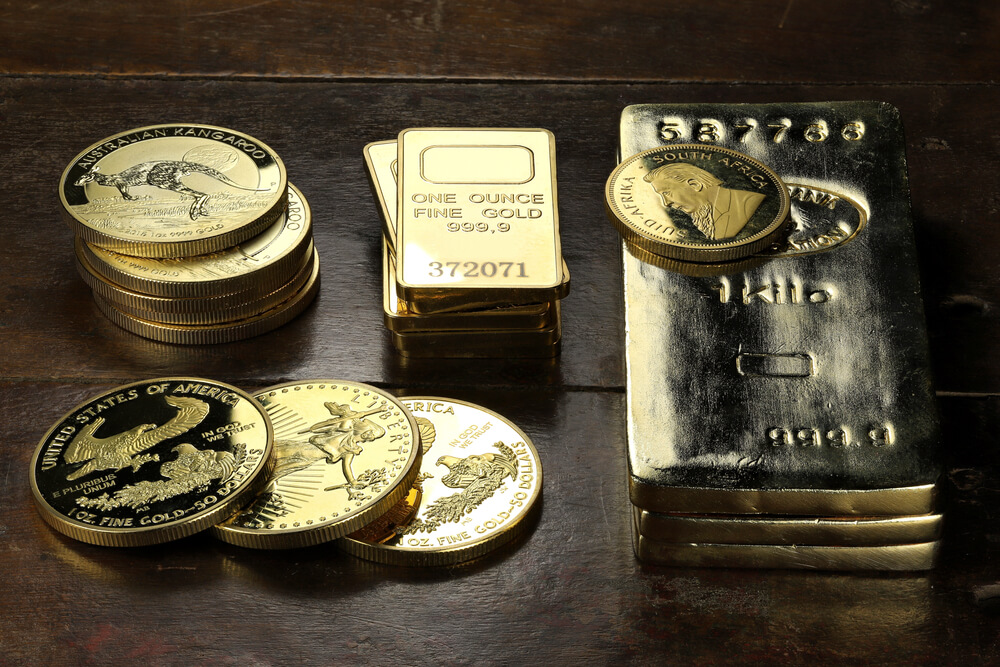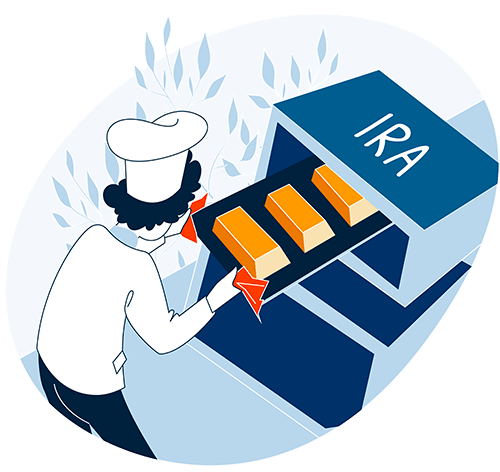
How to Convert Your 401k to Physical Gold?
Gold is a valuable and alluring metal. Regardless of what the experts say or how attractive various other investment options are, the masses' fascination with the tangible asset hasn’t decreased over centuries. Gold is arguably the most popular or sought-after investment metal globally since it can be lucrative financially in the long run. The precious metal may not generate returns as dividends or interest income, but those things don’t bother many investors or people smitten by the yellow metal.
Endorsing the above sentiment is an increasing number of traditional retirement account holders wanting to convert a portion or all of their savings to gold (we don’t recommend the latter ploy, however). For example, people with 401(k) accounts wish to have more than a sliver of gold in their retirement portfolio. And if you’re one of them but aren’t sure if that’s practical, we’d like to let you know that it is indeed possible.

In this article, we’ll discuss everything there is to the procedure. We’ll take you step by step through the process and throw light on everything you must know about and related to the conversion. The key topics of discussion for comprehensive understanding will be as follows:
- A brief introduction to a 401(k)
- The need to convert a 401(k) to gold
- How to go about the process
- Things to look at when making the conversion
- Answers to key questions and more
If there was ever a comprehensive guide to converting a 401(k) to physical gold, this would be it. Read on to learn how to make gold out of your 401(k).
Table of Contents
What is a 401(k)?
A 401(k) is a fully tax-deductible retirement savings plan sponsored by an employer. If you are a working professional based in the U.S., you can access the tax-advantaged retirement account. The money contributed to the fund is both employee- and employer-sponsored. Both the employee and employer’s share belong to the employee, but that depends on the “vesting period.” (More on that later)
The employer contribution is usually a portion of the worker’s share. Some employers, however, could offer to match 100% of the employee’s payments toward the retirement savings plan. The contributions are pre-tax money. Taxes apply during withdrawals. In case you’re wondering, a 401(k) is named so as it denotes the 401(k) tax code subsection of the American Internal Revenue Code.
How Do 401(k)s Make Money
The contributions made to a 401(k) are put in investment vehicles chosen by the employee from the options the employer provides. The choices are usually a mix of stocks, bonds, and mutual funds. Initially, the money is put into more risk-prone assets. As the employee approaches retirement age, the money is put in more conservative assets to ensure minimal investment loss risks at the fag end of the account.
Not to mention, the sum and consistency of the contributions made determine how much and how swiftly the money grows. The earlier you get employed and set up a 401(k), the higher your chances of withdrawing more during retirement, thanks to compounding. In a nutshell, compounding enables the reinvesting of savings-generated returns back into the 401(k), which make their own returns. After several years, your 401(k) account’s compounded earnings could be bigger than your account contributions.
Traditional and Roth 401(k)s
A 401(k) can be classified as either “traditional” or “Roth,” depending on when taxes are applied. With a traditional 401(k), taxes are not subtracted from your gross income, or the retirement planning account contributions are made with pre-tax money. Consequently, the taxable income for the year is deducted by the total contributions made during the period, termed as the tax deduction for the particular tax year.
Contributions to a Roth 401(k), on the other hand, are made with post-tax dollars or from the income that reaches your bank account after income taxes have been deducted. That means zero tax deductions during the contribution year. The money withdrawn during retirement won’t be subjected to any surcharges. Both the investment earnings and your 401(k) contributions are exempt. Taxes may apply if the individual retirement account holder takes distributions before turning 59.5.
Always consult a financial advisor before withdrawing funds from a traditional or Roth 401(k) to avoid avoidable taxes or IRS penalties. These withdrawal rules and the applicable charges are similar to a traditional or Roth IRA (individual retirement account). It’s worth mentioning that the option to choose between a Roth or traditional 401(k) is not made available by every employer.
Another 401(k) type is the “safe harbor 401(k).” The retirement plan works like a traditional 401(k), providing employees a tax-advantaged retirement savings method. The contributions made to the account can be of different types. One of them is the employer should contribute a minimum of 3% of the employee’s salary to the plan, even if the concerned employee doesn’t contribute anything.
“Vesting Schedule”
The vesting schedule of a 401(k) denotes the minimum period one must be employed to receive the complete employer contribution. For example, suppose the vesting time is at least three years, and an employee quits their job or is laid off (excluding mass layoffs) before the stipulated time period has elapsed. In that case, they stand to lose or forfeit the employer’s contributions to the 401(k). The waiting period approach is referred to as “cliff vesting.” This approach is acceptable if the employees are not waiting for three years or more.
Another common approach employed is a “graded” schedule. If the graded vesting period is six years, the employee will get 20% of the employer’s match after a couple of years in the company. They will receive 20% each year after that. By the sixth year, the employer’s match received will be 100%. Note that the six-year vesting limit is the maximum legally allowed timeframe.
These vesting periods are more employer-friendly and do not favor employees, particularly mobile workers. Longer or graded vesting times unfairly tether employees to their firms. The prerequisites seem like a toned-down version of an employment bond. If employees quit prematurely, they stand to lose significant money at retirement. As a counter, several 401(k) plans provide employees with quick ownership of the employer’s funds or immediately after the contributions are deposited.
Note that employers do not have complete rein over the matter. Also, they can be generous or shorten the vesting period—graded or cliff vesting.
Moving the 401(k)
If you’ve quit your job after meeting the vesting schedule requirements (if any), your former employer could let you pick between keeping the 401(k) with them or moving it to the new employer’s retirement plan. If the 401(k) stays with the previous employer, it will remain untouched.
The employer or employee will make no contributions. Existing 401(k)s are kept if the retirement funds accumulated are reasonably sizeable. If not, the employer will urge the account beneficiary to close the account or transfer the funds to a fresh financial planning arrangement.
Read more: Moving 401k To Gold Without Penalties
The Appeal of Gold Investing
Gold is a metal that has been deemed precious for centuries. Back then, when there were no official currencies, gold coins served as de facto monies. People believed in hoarding them and benefited in the long run. Therefore, it’s not hard to grasp why gold appeals to most people in today’s day and age. Regardless, here are some definite reasons why.
Portfolio Diversification
Converting a 401(k) to physical gold or a gold IRA is a move to diversify their savings or investment portfolio. A diversified portfolio can weather an economic storm better than any uni-dimensional or paper assets-only-focused investment bag. Physical gold helps spread risk and decrease a portfolio’s overall volatility, particularly in comparison to stocks and bonds.
Inherently Valuable
Physical gold is intrinsically valuable. Unlike fiat currency, it’s not tied to a bank, or no financial institution determines the precious metal’s value. In other words, gold retains its value during tough times or uncertain economic periods. The intrinsic value or tangibility renders gold particularly attractive to individuals fancying security and stability with their retirement savings.
Inflation Hedge
Gold is usually considered an inflation hedge. When the paper currency’s value declines, gold prices invariably increase or hold up, safeguarding your retirement savings’ purchasing power. Tangible gold also protects wealth or serves as a value store, providing protection and security against other asset classes’ potential devaluation.
What is Moving a 401(k) to Physical Gold?

Moving or converting a 401(k) to physical gold is essentially rolling over the account’s funds to a gold account or liquidating it to real gold. Since turning it into precious metal and keeping it in personal safes and bank vaults attract taxes, the conversion usually ends up as a precious metals IRA. If you’re willing to foot those tax bills, taking a 401(k) distribution and using the money to buy gold to hold in your personal vault or at home is technically possible.
A gold IRA is ideal if you keep the funds invested in gold but also want them to stay within the IRS (Internal Revenue Service) realm, eligible for retirement savings. In other words, when you roll over the funds to a gold IRA, the money invested will remain immune from taxes. The level of security and proper insurance coverage a gold IRA account affords are far superior to any attempts to store gold at home or on personal property.
A gold individual retirement account is a self-directed IRA that holds gold, silver, and other precious metals or commodities. Unlike traditional IRAs, a gold IRA permits physical gold investments and is not restricted to stocks and bonds. Precious metals IRA, such as a silver IRA, also enables physical gold and silver holdings. A gold IRA essentially means to purchase gold coins and bars. The physical gold bought under the gold IRA account will be stored in an IRS-approved depository. A gold IRA custodian will manage the self-directed IRA account.
Rolling over a 401(k) to a gold IRA could be “direct” or “indirect.” A direct rollover entails transferring the funds directly from the 401(k) to the gold IRA. An indirect rollover, on the other hand, requires withdrawing the 401(k) funds to your bank account. The money is then moved to a gold IRA. The account holder has up to 60 days to make this transfer without incurring taxes or penalties.
Why Convert a 401(k) to Physical Gold?
The best way to gain exposure to the gold market is directly investing in the actual metal. Because a 401(K) doesn’t permit investing in the physical commodity, the need for a part or complete conversion arises. In other words, 401(k) account holders cannot purchase or invest in gold as part of their retirement savings plan.
However, a 401(k) allows gold-related investments in gold stocks, gold ETFs (exchange-traded funds), or mutual funds, commonly called “paper gold.” A 401(k) account holder may also invest in gold stocks individually. As far as the specific reasons to convert a 401(k) into the yellow metal go, we’ve already discussed them above.
How to Convert Your 401(k) to Physical Gold?
First, talk to your former employer or 401(k) plan administrator besides your new gold IRA service provider to obtain the correct documents for initiating the process. The forms will throw light on your 401(k) account details, the contributions made, withdrawal sums, etc. Once the necessary documents are filled and the conditions are met, contact your past employer and the current gold IRA firm to confirm everything is correct and proceed.
The next thing to do is initiate the rollover or asset transfer between the two accounts. As stated earlier, it could be direct or indirect. If you’re going the indirect route or routing the transfer via your bank account, ensure you do it within the stipulated period so that the transition is seamless or you incur zero tax penalty. Kindly note that there could be specific fees linked to the transfer. Ascertain what they are, if any, to know your total costs.
Closely monitor the process and keep all the essential documents or paperwork for the procedure. Ensure conformance with IRS requirements and other regulatory obligations linked with holding the precious yellow metal in a retirement account. Converting a 401(k) to gold sounds easier than it is. Watch out for potential complexities and specific regulations involved. Thoroughly understanding the process and enlisting knowledgeable professionals is highly recommended.
Things to Consider When Converting a 401(k) to Physical Gold
Since converting a 401(k) to physical gold is essentially a gold IRA rollover, ensure you do business with a suitable gold IRA company. The last thing you would want is to associate with a relatively new firm with little to no reputation and experience handling precious metals.
The sign of a reliable gold IRA provider is its track record and transparency. The past shows how well the company has done or how satisfied its clients are. Transparency denotes how forthcoming the business is about its fee structure and its willingness to make amends if things go wrong. It also highlights the business’ customer support.
Reputable gold IRA companies effectively manage your IRA and deal with the other critical stakeholders in your gold individual retirement account: the physical precious metals dealer and depository. Dealing with the right gold bullion coins and bars dealer is vital to ensure gold purity and that it meets the IRS requirements. The quality could be circumspect if you buy gold or silver coins from any random jeweler on the market.
Some of the best gold IRA providers include Augusta Precious Metals, Goldco, Noble Gold, and American Hartford Gold, to name a few. To learn more about the best gold IRA companies, click here. Once you’ve found the gold IRA company you like, discuss your intention to do a gold IRA rollover with the firm. Also, let your employer know about your plans so they can lend a helping hand and quicken the process. Once the IRA rollover is done, you may buy gold coins and bars for your investment or retirement planning goals.
Moving a 401(k) to physical gold has its own challenges and risks. It’s, therefore, important you don’t make the moves on your own and talk to a financial advisor or gold IRA expert for guidance and advice. If you’re unsure about converting your 401(k) to a gold IRA, the finance professional will help you understand if it’s the right decision or if you could stall the move.
How to Liquidate the Converted Physical Gold in the Future?
Selling the gold in precious metals IRAs is pretty straightforward. You only need to know the specific steps to complete the job smoothly and without inviting avoidable costs.
First, let your self-directed IRA custodian know your intentions to liquidate the precious metal. The gold IRA trustee will help you learn the requirements to sell the gold and the options available. The various selling options include selling it directly to a precious metals dealer, auctioning the metal, etc.
Before contacting your gold IRA provider, get familiar with and assess market conditions. Evaluating the market trends will help ascertain the right time to sell or get maximum returns. Have all the necessary documents in place to facilitate a smooth transaction. Talk with a reputable transportation firm or your gold IRA custodian to move the gold from the depository to another facility or the designated buyer.
Remember to stay in line with IRS guidelines and regulations to sell physical gold in an IRA so that you do not incur penalties or have no potential tax implications linked with the liquidation. Keep the sales documents for tax reporting needs and other things. Ensure the sales’ proceeds head into a bank account or IRA account.
Read more: 401k to Gold Rollover Guide
Conclusion
Safeguarding wealth and having money in the bank should be the goal behind any savings strategy. And what better way to protect cash than buying gold coins and bars? If you have a 401(k), you may want to divert some of that money to or invest fresh cash in physical gold. And if you’re going that route, investing in gold IRAs is the first thing that must come to mind.
Although withdrawing a 401(k) and converting the cash into physical gold that can be stored at home is plausible, it isn’t recommended, particularly if you want to steer clear of tax penalties. A gold IRA is a safe way to buy physical gold, diverting some or all of that 401(k) cash and not rubbing the IRS incorrectly simultaneously.
Hopefully, you now clearly understand how to convert a 401(k) to physical gold. If you’d like to learn more about gold IRAs, browse our website and the various detailed write-ups related to the topic.
FAQs
How long does converting a 401(k) to physical gold take?
There’s no set time. It’s usually two to four weeks, based on the gold IRA firm you work with. The time consumed is usually to finish essential paperwork and wait for approval. If you’re particular about getting things done quickly, choose a company that facilitates the same. Review customer feedback of gold IRA companies to glean information about their turnaround times. Unsurprisingly, experienced service providers, such as Augusta Precious Metals and Noble Gold, can wrap things up quickly.
How do I choose the right company for converting my 401(k) to physical gold?
Go through the company’s reviews and ratings. Learn how long the company has been in the space and how well it has performed. If, during your research, the company’s name pops up many times on credible review and rating sites, it’s very likely a dependable establishment. But then, to ascertain whether the company is right for you and your needs, learn about its fee structure, minimum investment requirements, shipping options, customer support, etc., before deciding.
What are the various fees associated with converting a 401(k) to a physical gold IRA?
The different fees linked with a 401(k) to physical gold conversion are multifold. The setup and maintenance of a precious metals IRA entails various expenses and fees, such as transaction costs, custodial fees, storage costs, insurance, etc. If not learned about beforehand, all these costs could erode the investments’ value over time. Also, purchasing and selling the IRA gold could include premiums, spreads, and other transaction costs impacting the total expenditure of managing the IRA.
Can I convert a 401(k) to something else and not just gold?
Yes, you can roll over a 401(k) to several other investment assets besides gold. The options include a traditional or Roth IRA, annuity, stock market (stocks, bonds, mutual funds), real estate, etc. The alternatives at your disposal could vary or be suitable based on your risk tolerance, financial objectives, investment choices, etc. A cash withdrawal is also possible but not advised due to the premature withdrawal penalties and likely tax implications that may apply, reducing your retirement savings’ long-term growth potential.
Do all American employers offer 401(k)s?
Since it’s not mandatory for U.S. companies to offer a 401(k) or similar retirement savings plan, not every American firm provides 401(k)s to its employees. Regardless, a 401(k) is a widely used retirement savings scheme in the U.S. Whether a company chooses to offer the retirement account to its employees hinges on the firm’s size, financial capacity, overall benefits package, etc.
Due to the complexities and administrative costs linked to a 401(k), some smaller organizations, businesses, or startups could choose not to provide the plan. Instead, they may opt for something more cost-effective and straightforward with a lighter administrative burden, such as a SEP (Simplified Employee Pension) IRA.


